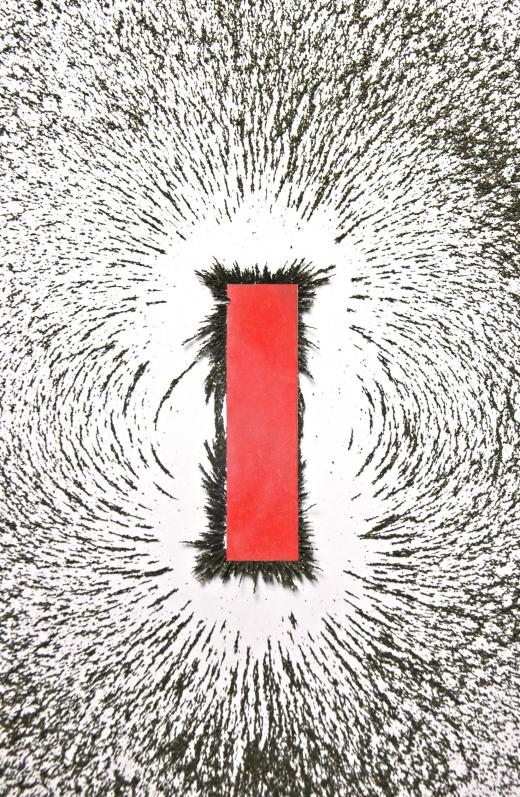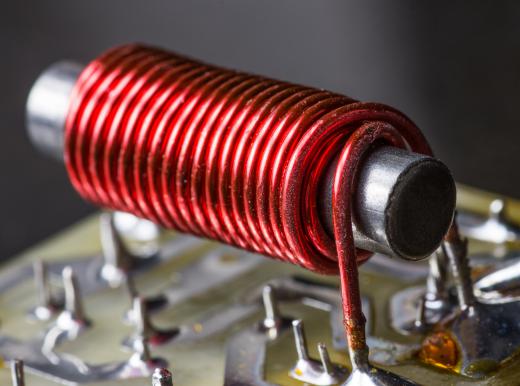How do Magnets Work?
 Nicole Madison
Nicole Madison
Magnets have magnetic fields that attract items containing iron. For example, some of the substances attracted to magnets include iron, nickel, and steel. Magnets are used for a variety of purposes, ranging from attaching items to refrigerator doors and creating compasses to providing for fast roller coaster rides and converting mechanical energy into electrical energy. They are even used in some toys.
Understanding how magnets work means figuring out the dynamics of a magnetic field. Consider the space that surrounds a magnet. This space is occupied by a magnetic force and is called a magnetic field. If a magnet is placed within this field, it will be acted upon by magnetic forces.

A magnetic field is created as the result of moving charges. A good example of this is electric current that flows through a wire. When this occurs, there are negatively charged, subatomic particles, called electrons, moving through the wire. As these charges move, a magnetic field forms around the wire. Likewise, the magnetic field of a magnet is created by the movement of electrons.

A magnet’s magnetic field either attracts or repels certain metals, as well as other magnets. A magnet has two ends that are referred to as poles. One pole is called north and the other one is referred to as south. To attract magnets to each other, you have to place opposite ends of two magnets near each other. Placing like ends of two magnets near each other causes the opposite to occur; the two magnets repel each other.

Interestingly, the Earth has a natural, magnetic field at is core. If you take a look at a compass, you will notice that one side is marked “N” and faces toward the Earth’s northern magnetic pole. As such, this part of the compass is referred to as the North-seeking pole. However, the Earth’s north magnetic pole should not be confused with its North Pole. The North Pole is located hundreds of miles away from the north-seeking pole.

Though most people are familiar with simple, refrigerator magnets, there are many other types of magnets. They are categorized as permanent, temporary, and electromagnetic. Permanent magnets maintain their magnetic properties for an extended period of time while temporary magnets lose their magnetism more quickly. An electromagnet, on the other hand, is one that is created using electricity. Its strength can be altered based on the electrical current that is allowed to move through it.
AS FEATURED ON:
AS FEATURED ON:
















Discussion Comments
It has been stated that everything in the universe is electromagnetic and yet it is also stated that everything has a charge, whether positive or negative. But is is also stated that the nucleus of the atom does not. Why?
If a bar magnet is composed of a N and a S pole what separates them? If the magnet is broken in two, you should have a single N and an
S pole but you don't. You have a completely new magnet. What happens to the middle?
You assumed today's nickels were made of nickel. They're more likely electroplated copper.
Someone's perpetuating a myth. I have before me a pile of nickels, and a stack of neodimium magnets from floppy drives and they don't attract to the coins before me. Sorry.
@Croewhome: Yes.
@Dayton: Less useful than you think.
@Anon5798: No, unless they wore ferrous hats and lived on space stations with highly magnetized floors. Your bones are stress-sensing and need/like to be in compression.
@anon14750: Exactly!
@anon42336: No. Field lines cannot be cut, but field intensity can be reduced (mu-metal).
@anon30356: Magnetism can be treated as electrostatics dressed up with special relativity. (last chapter of French's 'Special Relativity')
what materials are attracted to magnets?
Do magnets have anything to do with molecular attraction of solid materials?
@14: Magnetism is simply the force of electrical attraction and repulsion shifted sideways by the effects of general relativity. If electrical fields propagated instantaneously, then magnetism would not exist. But they don't. If charged objects are moving with respect to you the observer, you will "predict" different behavior to what they experience. This difference "looks" like a force, which we call magnetism.
As for electrical attraction and repulsion, the explanation seems to be that charged particles exchange photons with each other - that that's what electrical charge *is*. These photons carry momentum, and so electrons "exchanging" a photon are pushed apart.
Electrical attraction is weirder - the idea seems to be that positively and negatively charged particles are kind of traveling opposite directions in time. Or something.
Permit me to recommend "QED" by Feynman.
Magnetism is what electrical attraction and repulsion "look" like under lorentz transformations. That is, magnetism is relativity combined with Coulomb's laws.
@15 and @24: The link is that a particle's electrical charge is its propensity to engage in photon exchange.
@36: Oooh, I'd bet my house that it's an electromagnet.
@37: Magnets do not generate an "infinite" force of attraction, any more than an downward-sloping hill generates an "infinite" force of falling. There are plenty of perpetual-motion machine designs based on permanent magnets. None of them work. If they did, the would wold be a very different place.
about the tv thing, yeah i did that before. just wave the magnets around the screen until it's about back to normal.
Why is my pee yellow? Is it something to do with magnets?
Also, how do magnets generate this seemingly infinite energy of attraction?
How do switchable magnets work? The devices used on optical benches with the on/off switch. I don't think that they are electromagnetic. thanks.
To 15, they don't emit charged particles, the EM force is governed by photon exchange.
To 17, they behave the same in water, the water won't dampen the field.
To 18, the heat makes the molecules vibrate and gain energy, giving them room to point their little magnetic dipoles in different directions instead of them all mostly pointing in the same direction. Overall this cancels out the whole magnetic field.
To 19, yes, those are the three main elements that are magnetic.
do iron, nickel, and cobalt attract to magnets?
Why does heat depolarize magnets?
How do magnets react in water?
Preschooler question.
if magnets truly work with no molecule particles to act on it seems to me then they must then emit ionized or charged particles to create a magnetic field. the high and low charge may be the cause for rejection of each other. like static electricity, the molecules then repel each other depending on how the charged molecule is situated when it comes in contact with its opposite charge thus north /south poles/bdh.
Lots of information on what a magnet does, and the magnetic fields; but not one single thing on how. How does one magnet push or pull on another one? Not the usual junk but really how? or maybe we don't know? What is that force? Greg
"Please help. My three year old rubbed a magnet across my TV and now the color is messed up. can I do anything to fix this?" Call a few TV repair shops and asking if they can "degauss" a TV. If that fails you might try building a home made degaussing coil but there is a risk you can make things worse. Note that it might repair itself over period of weeks of switching it on and off in normal use. By off I mean off not standby.
Please help. My three year old rubbed a magnet across my TV and now the color is messed up. can I do anything to fix this?
Is there any material that can stop/block a magnetic force?
to #9 and #1: Magnets do not require air or any other medium to operate. Magnetic forces are transmitted through gases, solids AND vacuums. So, they work in space just fine.
Why do magnets work in space?
yes, magnets work in space. There are always magnetic fields to be attracted to. Or repelled from i suppose.
There are a lot of sensitive instruments in the spacecraft, none of which you would want being influenced by stray magnetic fields coming from, say, a flashlight with a magnetic clip. Velcro is the method of choice! Timothy A. Jones Sr. Systems Engineer
isn't cobolt able to attract?
would astronaughts be able to use magnets like a synthetic gravity? This might make their bodies fight the magnetic force like gravity, and in the least, slow the decaying process of their bones?
Yes, actually, they do. The conditions that make a magnet work have nothing to do with gravity or air. Though I don't know for sure, I would expect magnets to be very useful on a spacecraft to prevent things from floating around.
Do magnets work in space?
Post your comments